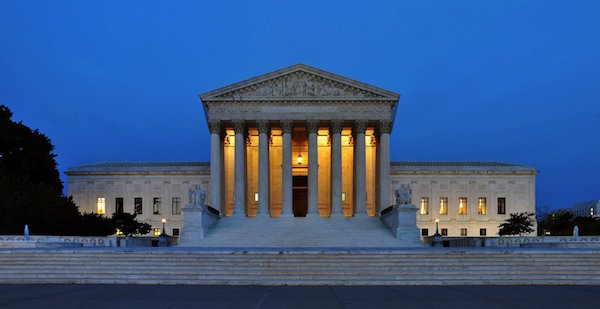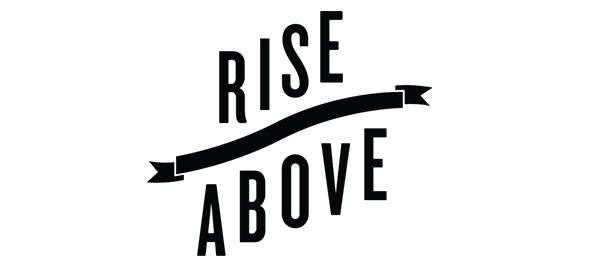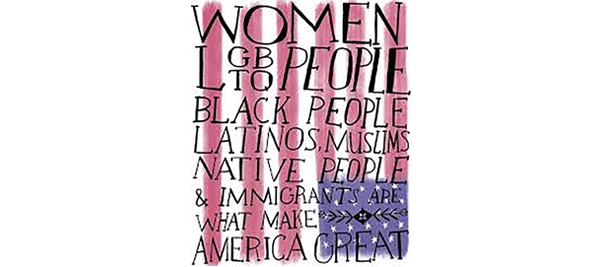-
Be cautious.
Don’t comment until you’ve seen the facts and the lead party’s statement. Remember, the first statement you make will be the most powerful. Comment to shape the conversation, not argue with the opposition about what the decision means. Consider your audience and the big picture of what those who read your statement will take away from it, and remember that if you jump in and don’t have a well-thought out point of view, that’s likely to be what your audience will remember.
-
Focus on what the case means to our shared values.
Consider the decision through your audience’s eyes. Most audiences are not at all familiar with – or even focused on – the outcomes of Supreme Court cases and their impressions will be shaped by headlines and topline rhetoric. It’s important to find ways to engage at that level, while providing detailed legal arguments only for audiences who want that. A great way to do this is to focus on values. Consider what the case suggests for the celebration or undermining of those values.
-
Avoid jargon…
In favor of plainspoken and accessible language that tells a story your audiences can digest, and that will spark action. Include stories, imagery, and metaphors that are memorable and stay with audiences longer than legal points.
-
Try to comment on the case, not the court.
If you don’t agree with a decision, it’s tempting to admonish the court for being out of touch. But remember that the Supreme Court is considering multiple cases impacting a range of issues across the social justice spectrum. Attacking the ideological profile of particular justices without discussing their alignment (or misalignment) of values in relationship to a decision can undercut a more favorable decision they may make on another issue. The way around this is to speak about what the case means to our shared values and national identity, and how decisions do or do not reflect those values. It may make sense to criticize the ruling, and specific justices’ opinions, but do leave room for the possibility that the court could rule more favorably on other cases. Try to refrain from comments that write off the court in its entirety.
-
Don’t focus on what the decision isn’t.
Discuss what it is. Explaining the legal details of what the case doesn’t mean is not as powerful as affirmatively stating what it does mean. Spending too much time telling audiences that the ruling does not outlaw abortion, for instance, only repeats the phrase and strengthens it in audiences’ minds.
-
Pivot to solutions and action.
While reporters covering the case may want “just the facts,” there are many opportunities to remind audiences of the solutions that the case highlights, and what they can do to make those solutions happen. Base audiences, in particular, will be fired up to do something whether in a celebratory or angry mood, so make sure to give them something concrete that they can do.
Messaging And Report Tag: social justice
Redefining Sanctuary
Introduction
This past February, as media reports began to circulate detailing a surge in Immigration and Custom Enforcement (ICE) raids in communities across the country, Americans took to social media to offer support and warnings to their neighbors. In the days that followed, as the true scope of the raids became evident, city leaders issued defiant messages critiquing the raids and reaffirming their support of immigrant communities. These efforts on the part of members of the public and elected officials crystallize the providing of refuge and safety at the core of the principle of ‘sanctuary’— a principle that defines the communities across the country, currently providing much needed legal protection to undocumented immigrants and their families.
A sanctuary jurisdiction can be defined as a locality that limits its participation in federal immigration enforcement efforts as a matter of policy. There are an estimated 47 sanctuary jurisdictions in the United States as of December 2016,[1] which, alongside policies like Deferred Action for Childhood Arrivals (DACA) and Deferred Action for Parents of Americans and Lawful Permanent Residents (DAPA), have enabled tens of thousands of undocumented immigrants to secure better paying jobs, and to pursue otherwise-unavailable education opportunities.[2]
Despite the integral role such immigration policies continue to play, the new administration has taken persistent steps to undo them. In recent months, there has been an increase in aggressive immigration enforcement policies, the latest of which includes the ending of DAPA and DACA programs initiated by President Obama.
In the face of these challenges, local governments, immigrant rights’ advocates, and policymakers have reaffirmed their commitment to the protection of immigrant communities. However, central to their continued success will be understanding how key audiences are currently thinking and talking about pro-immigration policies and immigration more broadly, and developing effective strategies to challenge anti-immigrant discourse. What issues and policies currently define the sanctuary jurisdictions debate? How does the current discussion of sanctuary jurisdictions intersect with DACA, and overall discussions of immigration in media coverage, social media discourse, and public opinion? How can pro-immigrant advocates ensure the continued support of immigrants and their families in an increasingly anti-immigrant climate? Finally, how can pro-immigrant advocates continue to uplift the voices and leadership of immigrants in a climate where many may feel reluctant to speak out?
In an effort to answer these critical questions, we embarked on a three-part analysis, which consisted of an examination of existing public opinion research, a content analysis of media coverage, and an analysis of social media discourse since January 2016.
Our analysis of existing public opinion research revealed that when asked specifically about deportation policies and levels of support for programs such as DACA, the majority of Americans support the protection of due process that sanctuary jurisdictions provide and, critically, oppose the types of aggressive deportation efforts promoted by the current administration. Our examination of social media data shows there is currently fertile ground for social justice advocates seeking to protect sanctuary jurisdictions and challenge misinformation that attempts to conflate the protection of undocumented immigrants with the promotion of crime. At the same time, our analysis of media coverage over a 20-month period suggests there is currently a pressing need for more coordinated messaging among pro-immigrant advocates.
This report begins with an overview of our findings from our analysis of social media trends over an 18-month period, followed by findings from our analysis of existing public opinion research, and mainstream media coverage. We conclude with a series of recommendations for messaging and audience engagement through social media outreach.
Citations
[1] Kenna, Ruairi, Politico, “Sanctuary cities stand firm against Trump,” December 2016,
[2] Center for American Progress, “State-by-State Analysis of the Economic Impact of DACA, DAPA, and DACA Expansion,” June 2015. Retrieved June 19, 2017.
Tips for Talking about the President’s Pardon of Ex-Sheriff Joe Arpaio
In 2011, the U.S. Justice Department sued then Maricopa County Sheriff Joe Arpaio for a “pattern of unlawful discrimination” against Latino Arizonans that included discriminatory and unjustified stops, searches, and detentions. As a result, a federal judge ordered him to stop these practices. Last month he was convicted of contempt of court for refusing to do so, opting instead to continue his harassment and intimidation of Latino Arizonans.
By pardoning him, the president sends a message that civil liberties are only for some, and that he is fine with law enforcement flouting the very laws they are meant to uphold. What’s more, on the heels of defending hateful demonstrators in Charlottesville, the president used his first official pardon to give impunity to a notorious violator of equal justice and our Constitution.
We recommend a two-pronged response to this news: 1) immediate condemnation of what Arpaio stands for: racism, racial profiling, and division – via a values lens; and 2) a pivot to the positive vision we have for a country that rejects racial profiling and every other form of racism.
Condemn the Arpaio mindset by describing the values at risk: equal justice, respect, safety, diversity. Frame the problem as a threat to these values.
- Racial profiling harms all Americans. It violates the American value of equal justice that we all depend on. It disrespects and discriminates against millions of young people and others around the country. It threatens public safety and can ruin people’s lives. It’s time to end racial profiling and focus law enforcement on evidence and public safety.
- We need to be clear: it is unacceptable for those who enforce our laws to stereotype people based on the color of their skin, religion, or nation of origin. Law enforcement should act on facts and evidence, not racial bias. If one group can be singled out based on race or ethnicity or religion, none of us will be safe to enjoy the rights that the United States stands for.
- We are stronger when we find ways to encourage participation and contribution, not ways to divide, exclude and discriminate. We have to condemn, in the strongest terms, those who engage in and encourage racist tactics.
- Is it right for a mother of Asian or Latino background who speaks with an accent to get asked for her papers—right in front of her children—when her white friend next to her does not? Is it right for a military veteran to be asked for his papers just because he’s of Mexican heritage? Is it right that immigrants who work hard and aspire to be citizens live in daily fear of being stopped, arrested, and deported away from their loved ones? Is it right to create a culture of suspicion in an America that becomes more diverse every day? No. Anyone who engages in or encourages discrimination is flat out wrong. That’s not who we are as a country.
Remind audiences that President Trump’s pardon of Arpaio reinforces a pattern of bigotry and discrimination in the wake of Charlottesville and long before.
- President Trump’s pardon of Arpaio doubles down on his defense of bigotry and discrimination in the wake of the Charlottesville hate march and Heather Heyer’s killing.
- The President’s pardon of Arpaio’s unconstitutional discrimination, his defense of hate mongers in Charlottesville, and his ban on transgender Americans serving our country are part of an unacceptable pattern of bigotry in his rhetoric, among his advisors like Stephen Miller and Kris Kobach, and in policies like the Muslim ban and the undermining of voting rights.
- People of good will, particularly in our government, must go beyond rejection or condemnation of the president’s words and deeds, and take action within the full limits of the Constitution to prevent him from inflicting greater discrimination, division, and harm.
Counter the Trump/Arpaio mindset with a vivid picture of what our country looks like when we work together and replace that suspicion with respect and cooperation.
- We are better, as people and as a country, when we welcome our neighbors, care for each other, and help those in need. We are better when we embrace our differences.
- We are stronger when we work together and when we learn from each other’s experiences, united as Americans. When people from different backgrounds join together, we all benefit from the diversity of those perspectives. It helps us find new ways to deal with old challenges. But we are not taking full advantage of this source of strength.
- Our country is changing, getting more and more diverse. It might make some of us uncomfortable, but it is our reality and a constant throughout our history. Politicians play on this fear, trying to divide us. They push unwise and divisive ideas like sending federal troops to police our cities, building a border wall, or singling out Muslim Americans because of their religion. If we take the bait on this, it makes our country weaker, not stronger. Our nation is stronger when every one of us can contribute and share ideas, and when everyone’s basic rights and dignity are respected. We need to embrace ideas that unify us as a diverse people and make our country stronger, and we need to speak out against discrimination wherever we see it.
Rise Above: Countering Fear-Based Messaging
The past few months have seen an increased volume of rhetoric that manufactures fear toward African Americans, Latinos, Muslims, and immigrants. Our goal in this research was to identify narratives that counter fear-based messaging, move persuadable Americans to embrace diversity as a foundational value, and to explore the particular words and phrases that motivate our target audiences to action.
Messaging Recommendations
- Talk about how we need to take advantage of our source of strength in diversity. Be aspirational, positive, and talk about embracing our differences.
- Define opportunity through the means that enable a tangible payoff: pursuing an education and getting a good paying job or career. Position discrimination as a barrier to opportunity and to those payoffs.
- Acknowledge that some people might be uncomfortable with change when asserting the importance of diversity.
- Highlight the importance of getting to know and accepting people from different backgrounds as a solution and a strength.
- When talking about universal values of being American that should apply to all people, explicitly say “no matter what someone looks like/where they come from/what their race is.”
- Talk about our need to hold the wealthiest corporations and individuals accountable for paying their fair share. People are prone to think in zero sum terms. Repositioning the “haves” as the wealthiest corporations (instead of people receiving government assistance) is more effective than trying to argue we all do better when we all do better.
- Talk about shared values of respect, dignity, and everyone’s basic rights.
Messaging Do’s and Don’ts
When opponents call it political correctness: Call out manufactured fear as “bait” from “politicians trying to divide us.”
When opponents talk about safety: Talk instead about strength and how fear makes us weaker.
Provide a strong call to action:
- Remove the barriers of discrimination that hold people back.
- Lean in to ideas that unify us as a diverse people and make us stronger.
- Speak out against discrimination and scapegoating when we see it.
Top Messages
Messages were tested for moment-to-moment responses in the online survey. Below are the winning messages that beat the opposition argument and increase people’s willingness to take action. The lines on the graphs are the moment-to-moment reactions to an audio recording of each message by our base, opposition, persuadables, and activists. People dialed positively (above 50) when they had a favorable reaction to the words, and negatively (below 50) when they had an unfavorable reaction. The number in parentheses represents the mean dial rating for that message. Passages in bold were especially effective.
Diversity as Strength
We are stronger when we work together and when we learn from each other’s experiences, united as Americans. When people from different backgrounds join together we all benefit from the diversity of those perspectives. It helps us find new ways to deal with old challenges. But we are not taking full advantage of this source of strength. If we embraced our diversity and valued the views of our fellow Americans, we’d be more likely to find solutions to our problems and better ensure that everyone has the opportunity to pursue their dreams. Whether white, Black, or Latino, whether Christian, Jew, or Muslim, we are all Americans. We need to embrace our different experiences, perspectives, and cultures because united we stand, and divided we fall.
Real America
America is a nation of values, founded on an idea -°©‐ that all men and women are created equal. And while we all have our circles, whether they are our family, co‐workers, or friends on Facebook, how we treat others outside of our circles reflects our commitment to the values that define us as Americans. It’s not about what you look like or where you were born that makes you American ‐ it’s how you live your life and what you do that defines you here in this country. We are better, as people, and as a country, when we welcome our neighbors, care for each other, and help those in need. We are better when we embrace our differences.
Pragmatism
Our country is changing, getting more and more diverse. It might make some of us uncomfortable, but it is our reality, and a constant throughout our history. Politicians play on this fear, trying to divide us. They push unwise and divisive ideas like sending federal troops to police our cities, building a border wall, or singling out Muslim Americans because of their religion. If we take the bait on these, it makes our country weaker, not stronger. Our nation is stronger when every one of us can contribute and share ideas, and when everyone’s basic rights and dignity are respected. We need to embrace ideas that unify us as a diverse people and make our country stronger, and we need to speak out against discrimination and prejudice when we see it.
_____________________________________________________________________ __
Methodology
Focus Groups: Lake Research Partners conducted six focus groups in 2017 in Charlotte, North Carolina on January 23, 2017 with white women and mixed gender African Americans, in Phoenix, Arizona on January 25, 2017 with white men and mixed gender Latinos, and in Baltimore, Maryland on February 15 with white men and white women. Participants were recruited to be moderate to independent lean-‐partisan, with a mix of marital status and education level. National Online Dial Survey: Lake Research Partners designed and administered a survey conducted online from March 1 through 6, 2017. The survey reached a total of 1,000 registered voters nationwide with oversamples of 100 African Americans, 100 Latinos, and 100 Millennials. The margin of error for the nationwide adults sample is +/-‐3.1%. It is larger for subgroups. The sample of activists was conducted March 2 through 24.
Rejecting Bigotry, Demanding Action
Shouting racist and anti-Semitic slurs, white supremacists brought hatred and violence to Charlottesville, VA, this weekend, culminating in the murder of Heather D. Heyer, an anti-racist activist. The hatred and attacks drew outrage, activism, and condemnation. But President Trump, incredibly, refused to name or condemn white supremacists, and blamed hatred, bigotry, and violence “on many sides”—a phrase he repeated twice. His statement two days later was vague, full of platitudes, and failed to call Ms. Heyer’s killing terrorism.
Protests, condemnations, and mourning must continue. Alongside these actions, it is important to call for leadership and concrete lasting change that includes, but goes far beyond, addressing this recent and terrible resurgence of white supremacist violence. We can’t remain caught in this moment of anger and disbelief. We have to continue our work to tell the story about what “America” really means.
Together with UnidosUS, The Opportunity Agenda completed public opinion and messaging research with this goal in mind: to tell a story of American diversity that reflects our values and our aspirations as a country stronger because of our myriad backgrounds, ethnicities, races, experiences – because of the parts of us that may make us different, but ultimately also make us stronger. This research provides guidance for those using their platforms to reject bigotry while demand action.
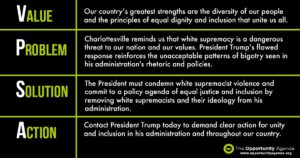
Lead with Values
Leading with shared values helps to persuade the disengaged and undecided while mobilizing the base of people who support equity, rights, and inclusion. Particularly important values here include Dignity, Respect for Human Rights, Equal Justice, and Diversity as one of our nation’s greatest Strengths.
Link diversity to problem solving, strength, and healthy communities rather than economic competition. Talk about how we need to take advantage of our source of strength in diversity. Be aspirational, positive, and talk about embracing our differences. And explicitly talk about those differences—e.g., “no matter what race someone is, where they come from, their religion, or whom they love.”
Consider these examples:
Our country’s strength stems from its diversity and the contributions made by men and women of different faiths, races, sexual orientations and political beliefs. America’s leaders must honor our fundamental values by clearly rejecting expressions of hatred, bigotry and group supremacy, which run counter to the American ideal that all people are created equal.
Mr. President – we must call evil by its name. These were white supremacists and this was domestic terrorism.
Our nation is defined by the march of progress. Our strength lies in our diversity. We must reject hate.
Name White Supremacy, Bigotry, Hate, and Terrorism
It’s important to accurately call out white supremacy and supremacists, racists and racism, Nazis and Nazism, bigotry, and hate where they exist. Terms like “nationalism” and “alt-right” do not carry the power or accuracy of these more specific terms. Similarly, we should name “terrorism” wherever it occurs, and whoever the alleged perpetrators. For example:
White supremacist violence is an unconscionable part of our nation’s history, but we cannot allow it to poison our future. Our nation’s leadership, on both sides of the aisle, must not only forcefully condemn it, but work actively and affirmatively to stop it.
What happened in Charlottesville is an act of terrorism pure and simple. This is one all too familiar to our country’s history. We’re standing with the peaceful protesters in Charlottesville, with our 1 million members across the country and with everyone tonight heartbroken like us. Let’s work together to ensure that tomorrow we don’t continue to replicate the horrors of the past.
Call out the history and spectrum of systemic racism in this administration and beyond
While the events in Charlottesville were terrible and dramatic, bigotry, white supremacy and bias are imbedded in our political and other institutions in ways that must be called out and explicitly linked. They include:
- Documented white supremacists in positions of power in the Trump Administration, including White House advisors Steve Bannon and Sebastian Gorka; Kris Kobach, vice chair of Trump’s election commission, who has documented connections to hate groups and a history of anti-immigrant and voter suppression activism, and Attorney General Jeff Sessions, who has spent his career undermining civil rights, and according to congressional testimony “used the n-word and joked about the Ku Klux Klan, saying he thought they were ‘okay, until he learned that they smoked marijuana.’”
- Donald Trump’s long and well-documented history of racism and bigotry, including denying that President Obama was born in the U.S.; contending that Judge Gonzalo Curiel could not rule on a case against him because of the Judge’s Mexican heritage; failing to disavow the support of Klansman David Duke; continually referring to U.S. Senator Elizabeth Warren as “Pocahontas”; disparaging Muslim Americans; labeling Mexican-Americans as “rapists” and other slurs.
- The Trump Administration’s unconstitutional “Muslim ban,” held by federal courts to be intentionally discriminatory based on religion.
- Action by the Trump Administration and Justice Department, led by Jeff Sessions, to abandon vigorous civil rights enforcement through consent decrees and other approaches; to challenge higher education diversity policies as discriminatory against whites; slashing civil rights enforcement by the Departments of Labor, Education, EPA, and other entities.
- The Trump Administration’s bogus “Election Integrity” Commission, led by Kris Kobach, rooted in a falsehood about non-existent voting problems, which has sought invasive voting information from the states and is clearly designed to infringe the voting rights of citizens of color.
- Attempts in many states to violate the voting rights of people of color, to exclude Muslims, and persecute immigrants, as well as the many hate crimes that have occurred around the country over the past year and have been ignored by this President and his administration.
Consider these examples of effective messaging:
President Trump’s press conference and tweets today are not enough. He must take responsibility for his role in propagating white nationalist ideology and fueling their movement. We call on him to immediately denounce the white supremacy movement by name and remove those who condone white supremacy, like Steve Bannon and Sebastian Gorka, from the White House. Their mere presence, and their prime roles in fanning these flames of bigotry, is a silent endorsement of this violence. There is only one side of hate, vulgarity, and violence.
I’m sure white supremacists remain reassured that they have a friend in the White House. A president who spews vitriol and heaps scorn on his enemies virtually every day – and who has no trouble calling Mexicans killers and “rapists” – still can’t break off the unholy alliance with bigots that he’s been cultivating since he first claimed President Obama’s birth certificate was bogus.
Reject Attempts to Dodge or Divide
Call out attempts to divide us, without repeating the other side’s message. An effective message from our research includes:
Our country is changing, getting more and more diverse. It might make some people uncomfortable, but it is our reality, and a constant throughout our history. Politicians play on this fear, trying to divide us. They push unwise and divisive ideas like sending federal troops to police our cities, building a border wall, or singling out Muslim Americans because of their religion. If we take the bait on these, it makes our country weaker, not stronger. Our nation is stronger when every one of us can contribute and share ideas, and when everyone’s basic rights and dignity are respected. We need to embrace ideas that unify us as a diverse people and make our country stronger, and we need to speak out against discrimination and prejudice when we see it.
Lift up Positive Solutions
After condemning the problem, turn to positive solutions, including systemic change. This can include, for example, removing white supremacy and its proponents, root and branch, from the government; aggressive civil rights and anti-hate crimes enforcement; upholding voting rights and dismantling the discriminatory “election integrity commission”; abandoning wrongheaded attacks on university diversity policies; ending the “Muslim ban” and halting attacks on sanctuary cities.
Beyond the administration, it’s crucial to demand that all policymakers and institutions reject and proactively eradicate supremacist, discriminatory, and exclusionary policies. It is unacceptable for any leader—governmental, business, faith, or otherwise—to remain silent in the fact of this crucial moment for the country. We must demand that leaders and institutions throughout our nation take a stand against white supremacy and bigotry, including inside their institutions.
Building Values-based Messages
We recommend structuring messages with a Values, Problem, Solution, Action formula. For example:
Value
Our country’s greatest strength is the diversity of our people and the principles of equal dignity and inclusion that unite us all.
Problem
The hatred and terrorism that we saw in Charlottesville are terrible reminders that white supremacy is a dangerous threat to our nation and our values. President Trump’s flawed and feeble response only reinforces the unacceptable pattern of bigotry in his rhetoric, among his advisors like Steve Bannon and Kris Kobach, and in policies like the “Muslim ban” and the undermining of voting rights.
Solution
The President must not only condemn white supremacy, bigotry, and violence, but also rid his administration of supremacists and their ideology, and commit to a policy agenda of equal justice and inclusion.
Action
Contact President Trump today to demand clear action for unity and inclusion in his administration and throughout our country.
10 Facts About Public Attitudes Toward Economic Opportunity
Freedom, opportunity, respect, and dignity – just some of the core values that many Americans say define them as individuals and a country. It was these same values that bubbled to the surface in a series of focus groups we held at the beginning of the year in three regions of the country. In collaboration with UnidosUS[1] and Lake Research Partners, we set out to examine how Americans were thinking and feeling directly following the November 2016 election. We found many people united in their concern about the divisive tone of politics and the treatment of people of color, and a shared willingness to act in support of positive change.
This memo draws on the results of this collaborative research project and provides an overview of key findings from a national online dial survey administered to a total of 1,000 registered voters nationwide in March 2017, with oversamples of 100 African Americans, 100 Latinos, and 100 millennials. The margin of error is +/- 3.1 percent for the overall sample and larger for subgroups.
In this memo, we focus primarily on segments of the population defined as the base, opposition, and persuadables[2]. Our base, opposition, and persuadables were created using a statistical cluster analysis that identified groups of like-minded voters based on the patterns of their responses to series of questions about their attitudes toward economic opportunity, diversity, racial inequality, and a variety of related topics. As of March 2017, roughly 33 percent of registered voters made up our base, 17 percent the opposition, and the remaining 50 percent represented persuadable audiences. While these segments correlate to some degree with political party affiliation, they are not entirely predictive of one another. For example, strong Republicans were more likely to fit the profile of persuadable than those who merely lean Republican. More information about the demographics of the base, opposition, and persuadables can be found in the Appendix.
Due to the sample size, we were unable to draw conclusions about three subgroups: Native Americans, those lacking a high school diploma, and those with non-college, post-secondary education. The sample size of each group was too small to make any reliable inferences.
Key findings from our latest analysis include:
1. Americans are united in their concern about the level of respect people in our country have for those from different cultures. Survey participants were asked how concerned they were about the level of respect people have for those from different cultural backgrounds on a scale of 0 (not concerned) to 10 (very concerned). A score of 5 was neutral. The majority of Americans across racial groups, political party affiliation, age groups, and education levels identified as concerned (i.e. reported a concern level of 6 or higher).
Across racial groups, Black Americans and Asian Pacific Islanders were most concerned, with 88 percent of Black Americans and 87 percent of Asian/Pacific Islanders expressing levels of concern 6 or higher. This compares to 83 percent of Latinos, and 79 percent of White Americans. Across political party affiliation, an overwhelming majority of “strong” Democrats[3] (90 percent) expressed high levels of concern about the current level of respect given to people from different cultures, compared to 71 percent of “not strong” Republicans. Across age groups, those under 30 were more likely to express concern than those aged 50-64, with 85 percent of voters under 30 expressing concern, compared to 79 percent of voters aged between 50-64.
2. Persuadables and the base report similar levels of concern over the tone of politics and political conversation. Roughly 87 percent of persuadables and 88 percent of the base reported a level of concern of 6 or higher on a scale of 0 to 10, where 5 was neutral. In contrast, only 67 percent of the opposition reported a similar level of concern.
3. Persuadables express serious concern with their ability to trust the media. When asked how concerned they were about their ability to trust the media, roughly 79 percent of persuadables reported a concern level of 6 or higher on a scale of 0 to 10, where 5 was neutral. In contrast, only 60 percent of the base and 70 percent of the opposition reported a similar level of concern.
When asked specifically about their level of trust in 12 different news sources, persuadables expressed significantly higher levels of trust in friends and family than traditional news media sources. However, persuadables express more trust in sources such as the New York Times, Washington Post, and CNN than right-leaning sources such as Fox News and Breitbart.
4. Persuadables have similar social media habits to the base, and both groups make more use of social media than the opposition. As Figure 2 indicates, the social media habits of persuadables track more closely to the base than the opposition. The most common social media platforms among the base and persuadables are YouTube, Twitter, and Instagram. In addition, persuadables and the base report more social media usage overall than the opposition. Roughly 18 percent of the opposition abstain from social media compared to only 11 percent of the base and 9 percent of persuadables.
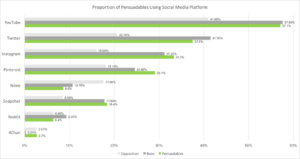
5. In contrast to persuadables and the base, the opposition reports more concern over “opportunity”, less over “inequality”. When asked their views about how serious a variety of topics currently are, a greater proportion of the opposition reports concern over the lack of opportunity (72 percent) than inequality (65 percent). Persuadables and the base not only have higher levels of concern overall, they also show similar levels of concern for both the lack of opportunity and inequality. Ninety-two percent of persuadables and 95 percent of the base reported concern over the lack of opportunity; 95 percent of persuadables and 98 percent of the base reported concern over inequality.
6. Persuadables have conflicting attitudes towards wealth, inequality, and the role of government. Ninety-one percent of persuadables believe that government has an important role to ensure opportunity for all. Further, 58 percent believe that wealthy Americans achieved their success because they had more opportunities rather than because they worked harder. At the same time, 74 percent believe that government assistance created a culture of dependency, and 68 percent believe that turning to government to solve problems will do more harm than good.
7. Persuadables are more likely to support social safety nets when a populist framework focused on the role of wealthy individuals and corporations is adopted. We randomly assigned half of survey participants to respond to the following question:
Which of two statements more closely reflects your views: A) there is “too much focus on helping people who take advantage of government assistance,” or B) the wealthiest corporations and individuals should “pay their fair share”. When framed as an issue of the wealthiest not contributing their fair share, 52 percent of persuadable respondents favored option B and agree that the wealthy should contribute more, compared to 39 percent who favored statement A.
The other half of survey participants were given a similar choice, but option B was modified: A) there is “too much focus on helping people who take advantage of government assistance,” or B) “everyone benefits when we help the people who need it most.” When framed this way, persuadables are more divided on their views, with 49 percent favoring statement A, and 41 percent favoring statement B.
8. Persuadables have conflicting views about people of color, personal responsibility, and discrimination in America. The overwhelming majority of persuadables believe that discrimination against Black Americans (88 percent), Latinos (73 percent), and Muslims (80 percent) is a problem. At the same time, 74 percent believe that “Too often minorities use racism as an excuse for their own failures” and 62 percent believe that “Blacks and other minorities who can’t get ahead in this country are mostly responsible for their own condition”. In contrast, only 27 percent of the base believes “minorities use racism as an excuse”, and only 41 percent believes “minorities are mostly responsible for their own condition.”
9. Persuadables believe strongly in the power of diversity to strengthen, unite, and better our country. Ninety-five percent of persuadables agreed that embracing diversity makes us strong as a country, and 93 percent agreed that it makes us united. Eighty-seven percent agreed that people from different cultural backgrounds make positive contributions to American society. This trend carries across political parties, racial groups, and age groups, with each subgroup responding very positively to diversity and its impact on the country.
10. Persuadables nearly unanimously believe we should counteract bigotry but are skeptical racial attitudes will actually change. Ninety-five percent of persuadables agree that “Everyone should try to do what they can to interrupt bigotry and prejudice,” and that “Everyone should try to do what they can to heal the wounds of bigotry and prejudice.” At the same time, 73 percent agreed that there is nothing “we” can do to change racial attitudes in America, and 74 percent agreed there is nothing “I” ( they personally) can do to change racial attitudes in America.
The overwhelming majority of Americans are excited to mobilize and bring about change. Eighty-five percent of the base is excited to “join together with other people to take action and bring about change.” Similar levels of motivation were reported across political parties, racial groups, education levels, and age groups. However, there was significant variation among education levels and age groups. More education and higher age are both associated with lower levels of excitement.
Audience Considerations
These findings have several implications for galvanizing support and collective action for social justice movements:
- Act now and give clear instructions. The survey strongly suggests that people are eager and ready to mobilize—the question is do they know how? On prejudice, for example, the majority agrees we should do everything we can to counteract it, but some voters remains skeptical that attitudes will change. Giving people concrete actions, or policies to support and explaining the positive impact those actions will have makes it more likely they will engage.
- Keep messaging positive. The majority of survey participants are concerned about the tone of politics and political conversation. Further, they do not trust the media. Leading with the problem is likely to dissuade potential persuadable audiences, who our research shows are currently eager to hear of ways they can positively engage. At a time when trust is low and people are concerned about the spirit of politics, focusing our messaging on the affirmative story and core values we want to uplift is critical to reaching persuadable audiences.
- Empower persuasion among family and friends. At a time when media trust is low, people are turning to family and friends as a source of news and political analysis. Therefore, empowering trusted constituents to move family and friends is an effective way to grow the base.
- Prioritize social media. Persuadables and the base have similar social media habits and use social media at greater rates than the opposition. Thus, communicating through platforms such as YouTube, Twitter, and Instagram is a cost-effective way to reach both the base and persuadable audiences already making heavy use of these platforms.
- Adopt a populist framework. Donald Trump’s successful presidential campaign is a clear indication that the populist framework is currently resonating with a large segment of registered voters. However, our findings also indicate that it is possible to move people toward progressive policy solutions by making use of a populist framework. The survey suggests that people are more amenable to government support of marginalized populations once reminded that government also subsidizes wealthy corporations and individuals. Further, the idea that the wealthy should “pay their fair share” was popular among both base and persuadable audiences, and can be used to encourage support for numerous social justice programs.
- Emphasize strength in diversity. Although survey participants have conflicting attitudes towards people of color, they have consistently positive attitudes toward diversity. The overwhelming majority of persuadables believes that diversity makes America strong and united. Further, they believe that people from diverse backgrounds make positive contributions to society. Advocates seeking to research persuadable audiences should link diversity to strength and problem solving, while also acknowledging that some people might be uncomfortable with change.
APPENDIX
Demographics: Base, Opposition, Persuadables
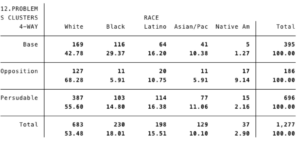
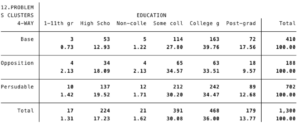
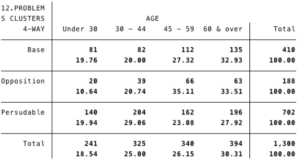
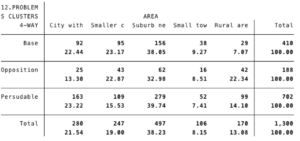
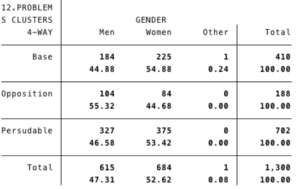
[1] Formerly the National Council of La Raza
[2] Persuadables are individuals who have attitudes that overlap with both the base and opposition. For a full breakdown of their demographic characteristics, see appendix.
[3] Those who strongly self-identified as Democrats.
5 Key Facts: Online Discussion of Immigration in The Trump Era
Introduction
As we enter the half way point of Donald Trump’s first year as president, the ripple effects of the new Administration’s policies have been far reaching. From the Muslim travel ban, to attempts to dismantle women’s reproductive rights, healthcare, and social safety nets—few have gone untouched in the past 6 months. In the face of these challenges, people across the country have rallied together to challenge the Administration’s attacks on freedom and democracy. Just this week, 45 states refused to provide Trump’s administration with voter data.
It is clear that transformative change is still possible and a collective future based on the shared values of diversity and inclusion is still very much within reach. However, central to our success will be understanding how to effectively reach persuadable audiences, and help them distinguish between legitimate policy concerns and the fearmongering that has come to characterize the Trump era. This requires a nuanced understanding of how Americans are currently thinking and talking about immigration, diversity, and demographic change.
In an effort to provide immigrant advocates, activists, and policymakers with a fuller understanding of attitudes toward immigration and related issues in the current social and political climate, we conducted a social media analysis of online discussions in the United States between January 1st 2015 and January 1st 2017.
The objectives of this research were:
- To map trends and shifts in online discussions of immigration, immigrant communities (specifically Latino and Muslim communities), and demographic change over a two-year period;
- Identify potential narrative openings to counter negative stereotypes and key influencers currently challenging toxic rhetoric online;
- Identify persuadable audiences and narratives that appeal to this segment of the online population.
Our findings indicate that online discussion of immigration, diversity, and demographic change have become more interconnected with discussion of terrorism and crime. The presidential campaign and election of Donald Trump appear to have played a direct role in this new interrelationship. Despite these troubling findings, social media is also emerging as a space where communities of color, Muslim Americans, women, and other traditionally marginalized groups are turning to express their own fears and challenge divisive rhetoric.
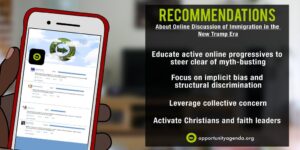
Methodology
The analysis of social media data was conducted using Crimson Hexagon, a leading social media analytics software which provides access to publicly available social media data including, but not limited to Twitter, Facebook, Instagram, blogs, forums/popular message boards such as Reddit, and mainstream news article comments, reviews, and YouTube comments. Crimson Hexagon enables users to create monitors for any topic or set of phrases and establish customized timeframes for data analysis. Once a monitor is established, Crimson Hexagon’s algorithm categorizes relevant social media data – identifying content volume trends, patterns in conversation, demographics, sentiment shift over time, and audience segment interests/affinities. Interests and affinities are generated by analyzing the social media habits of audiences partaking in particular online discussions (i.e. what brands, topics, or media sources this audience segment tends to share, which can then be compared to other audience segments.)
Using Crimson Hexagon, we examined online discussions of immigration, immigrant communities, and race/diversity in relation to issues of terrorism and crime between January 1st 2015 to January 1st 2017. In order to track how discussions concerning immigration and particular immigrant communities have shifted in the last two years, we created a buzz monitor[1] that included the phrases “immigration,” “immigrant,” “undocumented immigration,” “diversity,” and related terms. The goal of examining these broad terms was to examine how general discussions of these issues and communities have shifted in the last two years, identify when and how immigration and particular immigrant communities are discussed in the context of crime or terrorism, and identify potential openings for countering stereotypes and fear-based narratives.
The two-year timeframe enabled us to examine longitudinal data and identify more long-term patterns in the data. In the overall data population (which consisted of 59,246,987 posts), the majority of analyzed data originated from Twitter (76 percent of total sample), forums and blog post comments (18 percent of total sample), news article comments (6 percent of total sample), and other social media sites such as Facebook and Google Plus (3 percent of total sample). Sampled social media posts are accompanied by a Klout score, which is a number from 1 to 100 that represents how influential the person sharing the content is. Based on share of audience and reach, the more influential a person, the higher the Klout Score.
Key findings from our latest analysis include:
1. There has been a steady increase in the volume of online engagement around immigration and related topics within the last two years, with significant spikes in engagement following extremist attacks.
Over the past two years, over 59 million tweets, Facebook posts, and forum/blog/news comments have been written about immigration, immigrants, race and diversity in the U.S. On average, roughly 2 million social media posts involving immigration, immigrants, and broader discussions of diversity and race were posted each month in the United States during the period of time we studied.
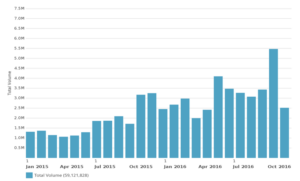
Between June 2015 and November 2016, there was a steady increase in the level of engagement in online discussions of immigration, immigrants, and related topics and three significant spikes in the volume of posts: November 2015, June 2016, and November 2016. The first two spikes in online engagement were a direct result of international and domestic attacks carried out by extremists – the first taking place in Paris, France in November 2015 and the second in an Orlando, Florida nightclub on June 12th 2016. The final spike in online engagement took place in November 2016 as a result of Donald Trump’s unexpected victory over Hillary Clinton in the presidential election.
2. The framing of online discussion of immigration has shifted dramatically since the start of Trump’s presidential campaign, with sharp increases in references to “illegal immigrants”, “illegal alien”, and “Muslim” within online content.
Reactions to domestic and international attacks on civilians and inflammatory statements made by Donald Trump have set the tone for the vast majority of online discussions concerning immigration and related topics in the last 12 months. Figures 2 to 4 depict a cluster of the most common phrases associated with immigration and immigrants in the United States from January 2015 to November 2016, with the larger words representing phrases which feature more heavily in online content.
As seen in Figure 2, at the onset of 2015, while discussions of “illegal,” “aliens,” and “Muslim” in relation to “terrorism” were present in online discourse, talk of “reform,” “amnesty,” and “uslatino” also featured heavily in online content. However, by December 2015 following the attacks in Paris, there was a significant shift in online discourse with “trump” and “realdonaldtrump” emerging as central phrases linked to overall discussions of immigration, alongside a more direct link between references to “immigration” with “terrorism,” “illegal,” and “ban”. As of November 2016, references to “trump” feature heavily as well as talk of “illegals” and a closer link between discussions of “Muslims” with “Latino” and “Hispanic” people.
Between January 2015 and January 2017, the percentage of posts making reference to “illegal immigrants” or “illegal alien” increased from 4 percent to 10 percent of total posts within our monitor. As shown in Table 1, as of December 2016, references to “Muslims” and “illegal immigrants” dominate online discussions of immigration and immigrant communities within our monitor.
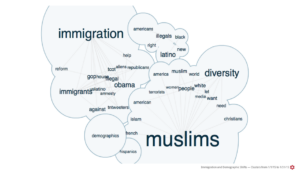
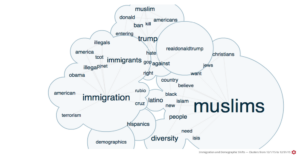
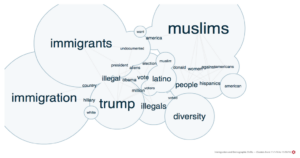
Table 1: Topic List: December 2016 Showing data from 10,000 posts
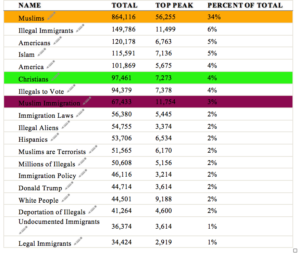
3. The majority of audiences engaging in online discussions concerning immigration reside in states with the highest concentration of immigrants in the country.
Using Crimson Hexagon’s demographic feature, we examined the location, gender, age, and race of audiences engaging in discussions about immigration and related issues online. From the total sample, 30,786,770 posts had an identifiable location. The majority of audiences engaging in online discussions concerning immigration, immigrants, and related topics are located in California (15.39 percent of sampled content), New York (10.28 percent), Texas (10.14 percent), Florida (7.29 percent), and the District of Columbia (4.23 percent).
4. A significant portion of individuals engaging in online discussion of immigration are people of color.
Roughly 75 percent of those engaging online are 35 and above (based on an analysis of 1 million posts), 8 percent are between 25-34, 10 percent are 18-24, and 7 percent are 17 or younger. In terms of race and ethnicity, online users skew heavily white, however there is a significant portion of Asian and Black people engaging in these online discussions. Currently, roughly 65 percent of online audiences discussing immigration and related issues are white, 16 percent are Black, 11 percent Asian, and 7 percent are Latino[1].
5. While conservative media outlets represent a significant portion of Twitter mentions and retweets, progressive and pro-immigrant voices have gained significant traction in recent months in terms of share of the total online conversation.
This following section provides an overview of the key Twitter influencers driving some of the online discussions around immigration, immigrant communities, race, and diversity more broadly. Top influencers on Twitter are the most active authors in a conversation over a particular time period, regardless of their influence (Klout) score. Influence on Twitter is determined by an author’s volume of tweets related to a given topic.
Recently, top mentions on Twitter related to immigration and immigrant communities, including discussions of Muslim and Latino communities, have been dominated by right-wing media outlets such as Breitbart and FoxNews (as seen in Figure 5). However, many of these mentions emerge in the context of individuals critiquing these outlets for anti-immigrant coverage. In addition, a significant portion of retweets from the month of December 2016 have come from progressive activists, comedians, or political commentators calling for unity and resistance in the wake Donald Trump’s election. JLUSA founder Glenn Beck, Modern Family actor Jesse Tyler Ferguson, and writer and political activist Shaun King are just some of the progressives speaking out in recent months and actively countering anti-immigrant and racist rhetoric.
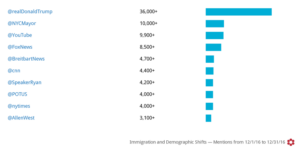
Recommendations
These findings present several important implications for messaging and audience engagement around immigration and diversity in America.
- Educate active online progressives to steer clear of myth-busting: Myth-busting currently occupies a significant portion of online communications made by the progressive community, particularly in reaction to political events. For instance, online discussions of immigration see significant spikes in the wake of domestic or international attacks carried out by extremists, particularly those self-identifying (or are identified by the media) as Muslim. Progressives online often seek to dispel or counter negative stereotypes in the wake of these attacks, but are unknowingly contributing to the negative association of immigration/immigrant communities with terrorism. Online progressives need to be educated about the pitfalls of myth-busting and reinforcing the narratives of the opposition.
- Focus on implicit bias and structural discrimination: In recent months, discussions of implicit bias and attempts to define racism have become prominent in online discourse related to immigration and diversity in America – representing an important shift in the level of sophistication around these issue areas. As seen in the two sample tweets below, talk of implicit bias and structural racism has gained significant traction among key online audiences (particularly fans of progressive comedians and actors such as Aziz Ansari). This represents an important opening for advocates seeking to promote new campaigns or activate key online audiences.

- Leverage collective concern: Much of the online discussions since the election of Donald Trump have focused on people expressing their fear and anxiety about the new administration. This form of expression has been highly intersectional and focused on the collective concern faced by women, Latino and Muslim communities, people of color, and LGBTQ people. For example, in November 2016, the following tweet from Mason Smith was shared over 100K times, while a tweet shared on the same day by activist Shaun King was shared over 42,000 times. Leveraging this emerging collective concern is critical to advocates seeking to develop messaging that galvanizes concerned audiences while uplifting positive values of diversity and unity.


- Activate Christians and faith leaders: References to “Christians” now occupy roughly 4 percent of overall discussion on immigration and immigrant communities (as seen in Table 1). Many online commentators have pointed to the seeming disconnect between the teaching of Christianity and the rising anti-immigrant sentiment that has come to characterize Trump’s rise to prominence. In addition, the pro-immigration messages of Pope Francis have been shared frequently in recent weeks, highlighting the rising importance of faith leaders and communities in countering anti-immigrant rhetoric.
[1] However, the lower percentage of Latinos is likely due the limitations of Crimson Hexagon’s racial categorization, specifically the difficulty in accurately assigning racial/ethnic categories to Latino users.
Ten Tips for Putting Intersectionality into Practice
We all deserve to have our voices heard; our faces and experiences reflected in culture and media; and our unique needs addressed through relevant policies. However, when we fail to incorporate intersectionality into our everyday practices and policies, we leave parts of our communities behind.
Intersectionality, a term coined by Kimberlé Williams Crenshaw, recognizes that certain individuals face multiple and intersecting forms of structural discrimination. In this political climate marked by division and anxiety, it’s important for us to work together to incorporate different communities’ experiences with culture, policies, and media.
We’ve compiled ten tips for putting intersectionality into practice to promote opportunity for individuals and communities who face multiple and intersecting forms of discrimination. This list can serve as a starting point for social justice advocates, policymakers, journalists, and researchers interested in incorporating an intersectional approach in their work.
1. MULTIPLE STRUGGLES
Recognize that there are multiple forms of systemic discrimination that block people from realizing equal opportunity in the United States.
An intersectional approach acknowledges systemic discrimination due to sexual orientation and identity, gender and gender identity, race, economic status, immigration status, national origin, and ability, among other aspects of one’s identity, and that this systemic discrimination impacts access to opportunity. However, recognizing these multiple, systemic barriers to opportunity and multiple forms of prejudice is only the first step in adopting an intersectional approach.
2. INTERSECTING OPPRESSIONS
Appreciate that forms of systemic discrimination intersect with each other and present unique challenges for affected individuals and communities.
In the real world, people are often subject not only to discrimination based on multiple aspects of their identity such as their race, gender, and immigration status, but also to discrimination unique to the “intersection” of their identities. So, for example, the stereotypes and obstacles faced by a Latina immigrant differ from those faced by women of other races, native-born Latinas, or immigrant Latino men. Intersectionality goes beyond acknowledging the multiple forms of discrimination, and recognizes that the different forms of discrimination may intersect with each other and result in overlapping and reinforcing barriers to opportunity. These overlap- ping systems result in unique forms of discrimination that only impact those in that particular community. An intersectional approach might include focusing on the unique challenges that those who sit at the intersections of overlapping systems of discrimination face, such as Black immigrants (who face both racial discrimination and discrimination because of their immigration status) or homeless transgender young people (who face discrimination because of their gender identity, age, and housing status).
IN ACTION: Reproductive care facilities in a rural town in Texas close because of state-wide abortion restrictions. An advocate committed to intersectionality would not only look at how the restrictions impact women generally, but also how particular communities of women in Texas are impacted. For example, an advocate might write an op-ed about how low-income Mexican American women in a rural community in the South are unable to obtain reproductive care because they cannot afford to drive to the nearest medical provider for reproductive care. This op-ed could also describe how these women are hesitant to drive to the community with a facility because its sheriff is notorious for profiling and arresting individuals whom he suspects are undocumented based on their race. Writing about this community of women highlights how abortion restrictions uniquely affect this particular group due to the intersection of economic barriers and discrimination based on gender, race, and perceived immigration status. It is vital to highlight how they face multiple and intersecting barriers to their reproductive health beyond how women, generally, are impacted by the Texas restrictions. Further, advocates could organize and develop policy solutions to address the issues these women face to ensure that the discussion about reproductive rights includes the experiences of women who face particular forms of harm while connecting economic, racial, and immigrant structural discrimination. The benefit of this op-ed might include encouraging new alliances, promoting solutions that consider the unique perspectives of different stakeholders, and centering their voices and experiences in the discourses about the issue. Taking an intersectional approach allows social justice leaders to focus on solutions informed by the experiences and voices of these women; engages and activates new audiences in ways that resonate with their experiences and values; and supports and uplifts the voices of these women within alliances, at town halls, social media, and letters to the editor.
IN ACTION: In The Opportunity Agenda report, “Public Opinion and Discourse on the Intersection of LGBT Issues and Race,” we looked at current public opinion and the role of ethnic and new media in both perpetuating and challenging myths and biases about LGBTQ people. The report examined the unique issues that LGBTQ people of color face and demonstrates an approach to research that is sensitive to intersectionality. Likewise, Black Lives Matter co-founder Alicia Garza adopts an intersectional approach to policing issues affecting black people and other people of color across sexual identity, immigration, and gender by advocating for a movement against police violence that includes the voices of black queer people, black people who are undocumented, and black immigrants.
IN ACTION: In The Opportunity Agenda report, “Reproductive Justice: A Communications Overview,” we describe several case studies that illustrate how campaigns have successfully adopted an intersectional approach in obtaining reproductive justice wins. For example:
Over the course of five years, from 2003 to 2008, the prevalence of rapes and sexual assaults on Indian reservations and the federal government’s dismal failure to investigate and prosecute these crimes went from being unknown to all but the victims and their families to being the subject of federal legislation. The issue’s movement from obscurity to the federal policy agenda happened in large part because of the efforts of the Native American Women’s Health Education Resource Center (NAWHERC) and other Native women advocates, and communications played an important role. Their success was based on a communications strategy that combined four components:
- Raising awareness within the National Congress of American Indians, the principal advocacy organization for American Indian and Alaska Native rights;
- Partnering with a human-rights organization with the resources to investigate, issue a report, and generate media coverage;
- Positioning themselves as the go-to experts on the issue;
- Engaging in media advocacy.
3. VOICE
Respect the voice of those most affected by issues by centering their voices, respecting their goals for their communities, and stepping aside and allowing them to serve as spokespeople for their own causes.
Intersectionality requires recognition of the voice of those most directly impacted, because they are frequently excluded from mainstream conversations. Valuing voice means lifting up, promoting, and supporting the leadership and storytelling of those most affected by policies and practices and centering their substantive suggestions and values into any given project and media advocacy. Impacted communities have direct experience that makes them thought leaders in the movement for social justice. Valuing voice allows those who are affected by policies to play a substantial role in building their own story.
IN ACTION: Being formerly incarcerated in our society is, in and of itself, a particular identity that affects how an individual navigates life. The barriers to opportunity that system-involved people face are in many respects their own unique form of systemic discrimination. Criminal justice reformers should consider consulting formerly incarcerated individuals and others directly affected by arrests and imprisonment, such as family members, people on sex-related registries, and crime victims and survivors, before making criminal justice policies. For example, there has been growing awareness about the harmful practices that criminalize poverty through the incarceration of low-income individuals because they are unable to pay excessive civil court fines and fees. Projects focused on reforming these practices might consult judges and lawyers about local municipal court practices that criminalize poverty. This project could also include consultations with family members of women of color who have been incarcerated because they were unable to pay civil court fines or individuals who have been incarcerated and solicit their input for policy recommendations that respond to their unique challenges within the legal system.
IN ACTION: Policymakers should consult women before making reproductive health policies. The history of reproductive health movement in the United States is the perfect example of how important voice is. The movement started out as a pro-choice movement that arguably failed to adopt an intersectional approach until the onset of the reproductive justice movement, which made sure to consider the reproductive oppression of women of color, immigrants, LGBTQ communities, and others in vulnerable, marginalized situations when fighting for reproductive rights. The reproductive justice movement went beyond abortion rights and incorporated intersectionality to address issues of access to female reproductive health care, immigrants’ rights, LGBTQ, sex worker rights, amongst many others. As a whole, the reproductive justice movement goes beyond the right to not have a child and includes the right to have children and the right to raise them in safe environments. In this way, the reproductive health movement transitioned from one dominated by the voice of middle-class, white women to include the voices of LGBTQ people, people of color, and low-income women.
4. INCLUSIVITY
Be inclusive and incorporate different perspectives when talking about your issues.
When speaking about issues, it is critical to recognize that there are multiple voices within a movement; that there is no singular way of experiencing an issue; and that various voices and perspectives need to be considered in order to make real, lasting, and equitable change. For example, when speaking about the need to promote accountable policing, advocates should be mindful to uplift the experiences of Native American individuals, transgender communities, and women to ensure that the movement is inclusive, as their experiences within the system are often different, play into different narratives, and require different policing solutions. The “success” of an intersectional approach may be as simple as ensuring different voices are included in the dominant discourse about an issue, or identifying ways that different communities experience policies and laws.
IN ACTION: Community activists who are concerned that an undocumented woman in their community with a prior arrest for shoplifting will be deported, might stage a direct action to develop a public narrative about the perils of increasing criminalization of the immigration system and to highlight how community members like this woman will be impacted. Following this action, they might organize community members to attend town hall meetings with their federal and local legislators, and host a Twitter chat to highlight that this country should be welcoming to immigrants and should give even those with past mistakes a second chance. Community members’ advocacy for this woman might include the voices of undocumented people who are college graduates and professionals who talk about their experiences being undocumented, but it should also be inclusive of individuals with different backgrounds to move beyond narratives of the “good immigrant” and the “deserving few.” Here, being intersectional ensures that we do not inadvertently throw anyone under the bus by promoting short-term objectives that undermine our long-term goal of expanding opportunity for everyone and respecting everyone’s dignity.
5. FAMILY
Acknowledge that individuals with intersectional identities may face unique challenges in how their families are perceived and in building and sustaining their families.
An intersectional approach recognizes the importance of family, and that families are defined by those creating and sustaining them. Assessing whether there are unique impacts on the family allows for policies that ensure that those they care for the most are protected. Furthermore, women often play an integral role as care providers to children and other family members, and it is important to recognize all family structures and kinds of parents regardless of sexual or gender identity, marital status, age or biological connection to children (in the case of adoptive families, grandparents raising kids, step-parents, etc.) in making this assessment.
IN ACTION: A reporter who covers criminal justice issues doing a profile of a black woman who has been wrongfully incarcerated might consider whether this woman was a primary caregiver prior to her incarceration. The reporter might consider whether the woman has lost child custody, and research whether parental termination rates are high in her community because women of color are being racially profiled. By doing so, the reporter is able to tell a systemic story about how families are also being impacted by racially discriminatory criminal justice practices and make the connection to how the incarceration of black women destabilizes families and jeopardizes child custody, particularly within families of color that may be facing challenges due to systemic discrimination. This story might include the perspective of family members, and consider the generational impact of criminal justice policies.
6. DISAGGREGATED DATA
Ensure that data collection does not overlook the experiences of individuals with intersectional identities.
We should encourage our government to be transparent and accountable. One way to do this is to require data from government actors. This data can be disaggregated by age, race, religion, sex, gender, gender identity/expression, housing status, sexual orientation, HIV status, ethnicity, sexuality, immigration status, national origin, and religious affiliation, depending on the actor and the accountability needs of the community. Often data is unable to tell the story of communities that sit at the intersections because the data only focuses on singular aspects of their identity. Highlighting the importance of disaggregated data ensures that the experiences of communities with intersectional identities are not missing and can be uplifted. It protects the voices of those who are directly impacted by ensuring their unique experiences are recorded. It is also important to disaggregate data within groups—e.g., while Asian Americans generally fair relatively well in terms of educational outcomes, there are significant differences among Asian American nationalities, with Hmong, Laotian, and Vietnamese children facing particularly steep challenges. The “model minority” stereotype about Asian Americans tends to obscure this reality.
Researchers should be sensitive to the need for disaggregated data in public opinion research and in gathering research samples. Wherever possible, it is important to “oversample” groups (and the intersection of identities) that might not otherwise be represented in adequate numbers to draw statistically valid conclusions. This “oversample” is simply an appropriate sample of these groups, which allows researchers to make inferences about groups that are often silenced by more traditional sampling approaches.
IN ACTION: If a civilian review compliant board interested in addressing gender discrimination in policing publishes reports about women who have been subject to excessive force, but fails to publish disaggregated data about the instances of excessive force that involve Latina women or Asian women, these women with intersectional identities are not reflected in the data. This type of data collection effectively silences the experiences of individuals who face prejudice because of skin color, ethnicity, and gender.
7. INTERSECTING ISSUES & CROSS-ISSUES
Be open to thinking creatively about social justice issues, assessing how issues connect with seemingly unrelated topics, and considering how they may have unintended consequences for other areas.
Criminal justice issues are related to public health issues, and public health issues to poverty, and poverty to immigration and so on. Incorporating a truly intersectional approach requires routinely considering how various issues may be impacted, how they connect with each other, and whether one approach with one issue area will somehow undermine efforts by those working on a different, but intersecting issue area. Promoting access to opportunity requires deliberate consideration of how seemingly unrelated issues areas connect.
IN ACTION: The Immigrant Defense Project works to promote fairness and justice for immigrants in the United States and examines how issues within the criminal legal system have a unique impact on immigrants. Its work cuts across the issues of immigration and criminal justice.
IN ACTION: The Sex Workers Project is a project of the Urban Justice Center that works across the intersection of sex workers’ rights, human trafficking, policing, and LGBTQ rights. The project provides direct services to immigrant sex workers, who police frequently profile because of their appearance.
IN ACTION: Organizations that do not explicitly work across different issues may nonetheless form partnerships with organizations that work on issues that impact their communities. A group of lawmakers interested in providing bail funds for incarcerated women of color may develop a relationship with community organizations that focus on enhancing child welfare and monitoring group homes to develop a campaign to ensure that primary care providers are not incarcerated for minor offenses. These lawmakers might pass legislation that provides funds for organizations to promote collaborations that are intersectional. Funders can similarly provide funding, host convenings, and encourage groups to work in non-traditional ways.
8. COLLABORATION
Strive to collaborate with people and/or provide resources for people from different communities, issue areas, and sectors to promote transformative change.
Intersectionality should encourage cross-community, cross-sector and cross-issue collaborations, investing equally in each others’ issues, narrative goals and policy agendas. Activists, advocates, lawyers, artists, scholars, cultural workers, and strategists should work with each other collaboratively alongside those directly impacted. These types of collaborations encourage innovative solutions, expand networks, and encourage transformative change.
IN ACTION: The relationship between grassroots activists in Flint, scientists in Virginia, lawyers in Detroit, and a determined pediatrician from Michigan led to the public exposure of the Flint water crisis. Collaborations that allow individuals to work across disciplines and issue areas may lead to innovative findings, policy recommendations, and cultural works as well as a more complete understanding and eventual solution to the issue(s). Funders for social change should move beyond traditional models to promote collaborations that may bring together unlikely allies.
IN ACTION: Organizers from Black Lives Matter and the Movement for Black Lives and organizers for border communities, such as the Southern Border Communities Coalition, have been fighting against the harms of a militarized and weaponized police force. While in different spaces, these organizers’ ability to develop a shared narrative about the harms of militarized police in the face of an unaccountable police force may prove to be an effective way for building support against the increasing militarization of police. Furthermore, organizations that work with sex workers, such as the Sex Workers Project, might also speak out about militarized police and speak about their experiences with federal agents during raids, where militarized equipment is used in order to create a drumbeat about the problems associated with a militarized police.
9. HEALTH
Consider how discrimination and systemic inequality contribute to differing health outcomes and block access to healthy food, clean water, and fresh air.
The health of communities that face intersectional forms of discrimination is often overlooked. One practical way to put intersectionality into practice is to ask whether the particular health needs of individuals and communities that face overlapping and intersecting forms of oppression are being met. Looking at health data in terms of the intersections of race, ethnicity, and gender, for example, might reveal that Afro-Latinas are experiencing unique challenges that are different from Black or Latino communities or from Afro-Latino men. Similarly, Asian American women face unique risks of ovarian cancer and screening methods developed for white women don’t meet Asian American women’s health needs.
IN ACTION: After Hurricane Katrina, it came to light that a Vietnamese community had been living in a part of New Orleans particularly prone to water contamination, and were doubly hit by the floods. This was having adverse health effects, but it was harder for them to get help because, due to language barriers, they weren’t as aware of how to access health care and there weren’t enough translators.
10. COMMUNITY
While working in collaboration, highlight the importance of coming together as a community to achieve equal opportunity.
Intersectionality should highlight the importance of community. Community is a salient value for many Americans. Intersectionality recognizes this connection to community and amplifies the importance of ensuring that all members of the community are respected and enjoy access to opportunity. We should strive to include everyone in our work toward promoting social justice. We are all in the fight together and should develop narratives that ensure that none of us get left behind. Building community and encouraging alliances, coalitions, and looking out for each other will help us solve problems.
Power of Pop: Media Analysis of Immigrant Representation in Popular TV Shows
Introduction
In the weeks following the 2016 presidential election, and the almost immediate threats posed to the civil liberties of immigrant and Muslim communities, the long-running sketch show Saturday Night Live emerged as one of the most vocal and widely viewed critics of the new administration. Melissa McCarthy’s now infamous characterization of White House Press Secretary Sean Spicer is just one example of the critical role humor and satire have come to play in challenging abuses of power and also in providing much needed relief and hope in the new Trump era.
Popular culture—which can be defined as “those elements of culture capable of sustaining and perpetuating themselves based on endorsements and participation by large groups of people”1—has long been recognized as a space of creative expression that has given way to lasting social and cultural change. Popular culture has the power to shape our understanding of complex issues and our attitudes toward people we perceive to be different.
However, when depictions in popular entertainment persistently reflect biases, stereotypes, and inaccuracies about people and communities, they help sow division and drive audiences toward unhelpful and inaccurate perceptions. Such negative outcomes have been widely documented in existing research, which has shown how patterns of stereotypical depictions of black men and boys, and communities of color in general can negatively affect people’s attitudes toward these groups.2 As popular entertainment continues to shape the cultural and political landscape, and is increasingly recognized as an important predictor of political decision making, identifying harmful trends and understanding how to counter them through better informed storytelling, media literacy, and advocacy will be of critical importance.
In an effort to better understand the role popular entertainment is playing in shaping attitudes toward immigrants and immigration, this report examines narratives concerning immigrants, immigration, and border communities within a medium with the largest reach and one of the highest levels of audience engagement—broadcast, cable, and streaming television. According to the latest data published by Nielsen, television remains the most widely consumed medium among American adults.3 Eighty-six percent of adults (aged 18+) watch television an average of 5 days a week. This figure increases to 92 percent for individuals 50 and older.4 These statistics do not include the millions of Americans who now access television content through streaming services such as Netflix, Hulu, and Amazon Prime. As of 2015, Netflix alone had an estimated 60 million subscribers. In addition to attracting large audiences, television programs have been shown to play a central role in shaping dominant narratives and social norms, particularly attitudes toward people of color, immigrants, formerly incarcerated people, and other traditionally marginalized communities.
This study sets out to answer several key questions: What are the dominant narratives concerning immigration, immigrants, immigrant communities, and related topics as presented in popular television programs; what common storylines or themes emerge; what types of characters or spokespeople are generally represented; and how are these overarching narratives, themes, and characters discussed by engaged audiences on social media?
The report begins with an overview of the frequency and quality of immigrant character representation, dominant narratives, and themes that tend to be associated with immigrants and immigration and concludes with recommendations for audience engagement.
Acknowledgments
The Opportunity Agenda wishes to thank and acknowledge the many people who contributed their time, energy, and expertise to the research and writing of this report. The media content analysis was designed and conducted by Austen Lazarus and Lucy Odigie-Turley. The report was written by Lucy Odigie-Turley, and the recommendations were drafted with the support of Julie Fisher-Rowe, Betsy Richards, and Janelle Heller-Treibitz. Accompanying illustrations were created by founder and president of Graphic Advocacy Project, Hallie Jay Pope, and the report was designed and formatted by Lorissa Shepstone of Being Wicked. This research was supervised and edited by Juhu Thukral.
We also want to express our great appreciation to Margo Harris, who edited and proofread the report, and Ross Mudrick for providing publication and editing assistance.
Finally, this research would not have been possible without the generous support of our funders: Unbound Philanthropy, The Ford Foundation, The Ford Freedom Fund, Oak Foundation, The Nathan Cummings Foundation, Libra Foundation, JPB Foundation, The Open Society Foundation, and W.K Kellogg Foundation.
About The Opportunity Agenda
The Opportunity Agenda was founded in 2006 with the mission of building the national will to expand opportunity in America. Focused on moving hearts, minds, and policy over time, the organization works with social justice groups, leaders, and movements to advance solutions that expand opportunity for everyone. Through active partnerships, The Opportunity Agenda synthesizes and translates research on barriers to opportunity and corresponding solutions, uses communications and media to understand and influence public opinion, and identifies and advocates for policies that improve people’s lives.
1 PopJustice, Nathan B. Cumming Foundation, 2016, p. 11. Retrieved April 17, 2017.
2 The Opportunity Agenda, ”Media Portrayal of Black Men and Boys,” 2013. Retrieved April 20, 2017.
3 Nielsen, “The Nielsen Total Audience Report Q1 2016,” 2016. Retrieved January 15, 2017.
4 Ibid.
Tips for Talking About Law Enforcement Enhanced Penalty Laws
Protect Community Safety by Rejecting Enhanced Penalties1
We all want safe communities and to feel protected and secure. Violence against anyone threatens that, and we all have a responsibility to stop, prevent, and condemn violence in any form.
But the recently proposed laws that require enhanced penalties for offenses involving law enforcement officials don’t do that. There are already adequate laws that ensure that those who compromise police officer safety are penalized, making enhanced penalty laws wasteful and unnecessary. Moreover, these proposed laws have additional consequences that harm communities in the long run. They impair the relationship between police and communities, interfere with people’s ability to come together as a community in peaceful demonstrations and protests, and they do nothing to improve officer wellness.
Legislators should vote no on these proposed laws that would only end up hurting communities. Instead, lawmakers should focus on policies that improve the relationship between police and communities, and that improve officer wellness and health.
Vote no on these bills and uphold true community safety.
Value at Stake: Community Safety2
1. Enhanced penalty laws would compromise community safety and impair the relationship between community members and the police.
- In a time when the public is interested in more accountable and responsible policing, enhanced penalty laws would only impair community relations and create a legitimacy crisis, wherein community members perceive police officers as attempting to become a “protected class” that is above the law.
- Enhanced penalty laws are often described as hate crime statutes, which intend to protect those who have experienced a “long legacy of violence, intimidation, and discrimination.” Using these laws, which are intended to protect people against discrimination because of their skin color, faith, LGBTQ status, or the fact that they have a disability, will only drive a wedge between law enforcement officers and the community.
- Instead, lawmakers should address “rifts in the relationships between local police and the communities they protect and serve.”
- We need to address excessive force, biased policing and other police practices failing our communities.
- We need to address the 1,092 people killed by police in 2015 as estimated by The Guardian.
2. Officer wellness and safety can be enhanced by improving officer training and promoting best practices.
- The Task Force on 21st Century Policing set forth recommendations to promote officer safety that include training and best practices.
- We should invest in officer and community wellness and safety instead of spending $80 billion a year on mass incarceration.
Sample Message:
- It is incredibly important to ensure that law enforcement officers are safe so they can carry out their duties effectively. These types of bills do nothing to invest in officer wellness or to address the everyday challenges faced by officers. They are redundant, especially because there are laws that protect officers from violence in all 50 states.
Sample Message:
- We need policies that protect everyone, law enforcement and community members alike — and a commitment to working together to build safe communities. These kinds of bills would only erode police-community relationships and thus threaten safety for both the community and police officers.
- Rather than take seriously the concerns communities have about the police officer’s use of excessive force, discriminatory policing, and lack of accountability for police violence, these bills further criminalize communities and will only worsen policy-community tensions.
- At a time when our country needs to build unity, these bills sow division between police and the communities that they protect, serve, and rely on. They will only make the job of law enforcement harder than it already is.
- Instead of providing a bridge for communication, proponents of these bills are only isolating communities and stifling the necessary dialogue that could lead to safer communities and safer law enforcement officers.
Values at Stake: Pragmatism and Commonsense Solutions
3. Enhanced penalty laws are wasteful and unnecessary.
- All 50 states have laws that make it a serious crime to assault or kill law enforcement officers.
- Federal law (18 U.S.C. § 1114) requires the death penalty or a life sentence for killing a federal officer.
- Federal law (18 U.S.C. § 1121) imposes a death or life sentence for killing a local officer involved in a federal investigation.
4. Enhanced penalty laws would fuel mass incarceration.
- These laws could result in hundreds of new offenses and federalize crimes already prosecuted by the states.
- Some of these bills impose mandatory minimums for assault.
- Some of these bills impose the death penalty though capital punishment, which has not proven to be a deterrent.
Sample Message
- Our current criminal justice system is overly punitive, costly, and racially biased. This type of legislation would only exacerbate these aspects of the system and is counterproductive to ongoing efforts to put in place smart, commonsense reforms that will make the system more fair and efficient and keep Americans safe.
Values at Stake: Human Rights and Our Constitution
5. These laws threaten free speech and assembly.
- Being able to come together as a community in peaceful demonstrations and protests is a foundational value that is enshrined in the first amendment of our Constitution. This value is core to our identity as a nation.
- However, law enforcement officers have at times created barriers in the exercise of speech by responding to demonstrations with militarized equipment, aggression, and widespread arrests. This type of response often threatens the exercise of free speech and violates the human rights of protestors.
- Enhanced penalty laws would increase the penalties for people facing trumped up charges during mass arrests at a protest, undermining the community’s ability to exercise free speech.
6. Enhance penalty laws would encourage racial profiling and discrimination by police officers.
- Officers are more likely to perceive people of color, LGBTQ and HIV affected people, and people with disabilities as aggressive. They are more likely to charge these communities with resisting arrest or assault on an officer, especially if the officer is covering up excessive force, discriminatory treatment, or other wrongdoing.
- Enhanced penalty laws would allow officers to profile these communities and then subject them to stiffer penalties and sentences because of the alleged “hate crime” that might result from these unnecessary interactions. These incentives to profile, discriminate, and further penalize communities that already have tense relationships with the police, undermine our commitment to human rights and equal justice. Instead of more criminal penalties, let’s invest in bias training that can improve relationships between police and communities.
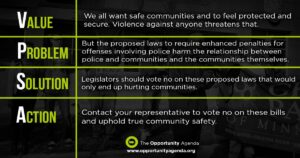
1. This memorandum was prepared in collaboration with members of the Justice Roundtable.
2. For more information about the role of values-based messaging and for tips on speaking about policing issues generally, visit Talking About Policing Issues.

